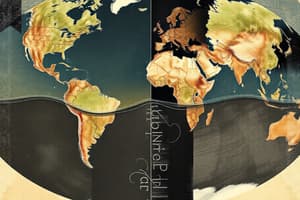Podcast
Questions and Answers
How does the uneven distribution of renewable resources impact energy production?
How does the uneven distribution of renewable resources impact energy production?
- It leads to specialization, where certain areas focus on specific types of renewable energy based on their availability. (correct)
- It has no impact on energy production.
- It ensures all regions can produce the same amount of renewable energy.
- It encourages all regions to deplete their renewable resources at the same rate.
Why are nonrenewable resources unevenly distributed around Earth?
Why are nonrenewable resources unevenly distributed around Earth?
- Because renewable resources are always found nearby.
- Because they are formed by geologic processes that occur in specific places. (correct)
- Because they are intentionally moved to different locations by humans.
- Because they are evenly spread by natural disasters.
How can human activities change the distribution of freshwater resources?
How can human activities change the distribution of freshwater resources?
- By constructing dams, which alter water flow and availability in different regions. (correct)
- Human activities cannot change this distribution.
- By evenly distributing water resources through pipelines.
- By creating new renewable water sources through desalination.
Which of the following is an example of a natural hazard that is currently difficult to predict?
Which of the following is an example of a natural hazard that is currently difficult to predict?
How can increased scientific understanding of natural hazards benefit communities?
How can increased scientific understanding of natural hazards benefit communities?
What is a significant negative impact of deforestation on the environment?
What is a significant negative impact of deforestation on the environment?
Why does the impact of human activities on the environment tend to increase with population growth and resource consumption?
Why does the impact of human activities on the environment tend to increase with population growth and resource consumption?
What is the primary cause of climate change?
What is the primary cause of climate change?
What role do greenhouse gases play in Earth's atmosphere?
What role do greenhouse gases play in Earth's atmosphere?
How can individuals and societies mitigate the negative impacts on the environment?
How can individuals and societies mitigate the negative impacts on the environment?
Flashcards
Natural Resource
Natural Resource
Anything found in nature that can be used by humans.
Renewable Resources
Renewable Resources
Can be replaced over human lifetimes.
Nonrenewable Resources
Nonrenewable Resources
Cannot be replaced over human lifetimes.
Natural Hazard
Natural Hazard
Signup and view all the flashcards
Climate Change
Climate Change
Signup and view all the flashcards
Greenhouse Gas
Greenhouse Gas
Signup and view all the flashcards
Deforestation
Deforestation
Signup and view all the flashcards
Human Activities Impact
Human Activities Impact
Signup and view all the flashcards
Study Notes
- A natural resource is anything found in nature usable by humans.
- Natural resources exist in two forms: renewable and nonrenewable.
- Renewable resources can be replaced in a human lifetime, whereas nonrenewable resources cannot.
- Renewable resources' distribution varies across the Earth.
- Areas with higher wind activity can generate wind energy more efficiently.
- Nonrenewable resources are also unevenly distributed.
- The distribution of nonrenewable resources stems from geologic processes.
- Building a dam can increase fresh water in one region while decreasing in another.
Natural Hazards
- A natural hazard constitutes any natural event posing a risk to humans or the environment.
- Tornadoes, hurricanes, earthquakes, and volcanic eruptions are examples of natural hazards.
- Hurricanes typically get forecasted days in advance using satellites and technology.
- Earthquakes occur suddenly and without warning.
- Increased knowledge of natural hazards helps make better predictions and allows communities to be more prepared for future hazards.
Human Impact on the Environment
- Human activities impact the environment through land and water use, deforestation, and burning fossil fuels.
- Clearing forests causes habitat loss and puts other species at risk.
- Negative human impacts escalate with population growth.
- Increased natural resource use per person also increases negative human impacts.
- Science helps identify solutions to reduce our impacts on the environment.
Climate Change
- Earth’s average temperature is rising, causing long-term shifts in global weather patterns, leading to climate change.
- Greenhouse gas emissions primarily cause climate change.
- A greenhouse gas traps heat in Earth’s atmosphere.
- Human activities have added too much greenhouse gasses to the atmosphere.
Studying That Suits You
Use AI to generate personalized quizzes and flashcards to suit your learning preferences.




